The week at a glance
- Bufflehead in Lancashire
- American Buff-bellied Pipit still in County Cork
- Barrow's Goldeneye still in County Down
- Probable Pacific Diver again in Cornwall
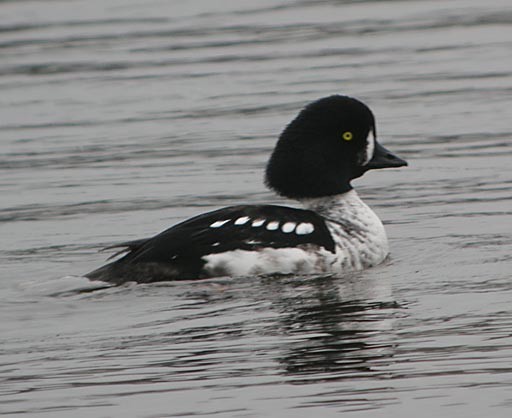
Barrow's Goldeneye, Quoile Pondage, Down (Photo: Tristan Reid)
A late-winter blast of cold air, strong northerly winds and some significant Easter snowfalls appeared to have little or no effect in deterring the holiday weekend birders from getting amongst the action and getting out in to the field. Top billing this week goes to the female Bufflehead seen near Leyland (Lancashire) for one night only, on the evening of 23rd. Searches on the 24th sadly revealed nothing, the bird (hopefully) continuing its journey north. There is every chance that this bird could have been the real deal - it is a great time of the year for Nearctic ducks to wander and many people's first Bufflehead experience came in March 1994, with the dapper drake in Nottinghamshire. That said, escapes are, of course, known... In County Cork, the American Buff-bellied Pipit was still to be found along Red Barn Strand, Youghal, until at least 21st, while the rather scruffy drake Barrow's Goldeneye at Quoile Pondage (Co. Down) remained until 23rd. In Cornwall, the probable Pacific Diver in St. Austell Bay was seen again on 25th but, once again, managed to elude a definite identification.
A White-billed Diver was reported in the harbour at Aberdeen on 25th. Just one Pomarine Skua this week, seen near Cliffe Pools RSPB (Kent) on 23rd, and a Grey Phalarope was seen at Musselburgh Lagoons (Lothian) on 21st, though it had gone by the following morning.

Cattle Egret, undisclosed site, Somerset & Bristol (Photo: Jeff Hazell)
As April begins to loom, the number of Cattle Egrets being seen (or at least reported) is starting to drop. The southwest of England was still very much the focal point in terms of numbers of birds, and it was still Cornwall where the largest group remained - with at least 12 birds still around the Sancreed area to 26th (with eight birds still there to 24th at least). Five birds were seen near Ladock on 23rd, and at Stithians Reservoir two birds were noted from 20th-22nd at least. In Devon, five birds lingered at Warleigh Point to 24th while, at the opposite end of the county, four birds remained at Southcott Valley, near Bideford to 21st, with up to three at Fremington Pill to 26th. Up to four birds remained around the Kingsbridge Estuary to 24th and two birds could still be seen at Aveton Gifford to 26th. Singles were seen at Colyford to 20th and at Newton Abbot on 24th-26th. In Dorset, two birds were seen this week; over Stanpit Marsh on 20th and at Abbotsbury the following day, this bird remaining to 26th. In Hampshire, the lone bird remained at Harbridge to 26th, while in West Sussex, two birds were again at East Lavant from 20th-24th. A new find was a bird near Molesworth (Cambridgeshire) on 26th. In Wales, the Cattle Egret at Llandre (Ceredigion) was present from 20th-26th, while eight birds were still to be found at Ballycrompane (Co. Waterford) to 23rd.

Common Crane, Horsey, Norfolk (Photo: Craig Shaw)
After such steady totals for much of the winter, this week saw the number of Great White Egrets reported reach just four birds. The bird on Shapwick Heath NNR (Somerset) was still present from 20th-23rd at least; also on 23rd, on South Uist (Outer Hebrides) a Great White Egret was again seen on Loch Grogarry (the sixth report from here since mid-January). On 25th, a Great White Egret flew over Hugh Town, St. Mary's (Scilly), with another reported in Thornham Harbour (Norfolk) on the same date. Some 15 Spoonbills were noted this week, with 11 at Middlebere, Poole Harbour (Dorset), on 24th accounting for most of the haul. Two others were seen in Dorset, with singles in Cornwall and County Kerry making up the numbers. With no mention of the Spanish-ringed Glossy Ibis in Lincolnshire this week, it's down to Lancashire's "Old Faithful" at Warton Marsh to, once again, be the species' sole UK representative, present to 24th. Very few Common Cranes were reported this week: two birds were still at Queen Elizabeth II CP (Northumberland), remaining in the area until 26th. Two were seen near Horsey Mill (Norfolk) on 25th, while a single bird was reported from Kirkby-in-Ashfield (Nottinghamshire) on 25th. Staying in the northeast, a White Stork was noted around Yarm (Cleveland) on 20th. On 26th, a Quail was seen twice in flight at Reculver (Kent). A migrant presumably, but could it have been a wintering bird perhaps?

Snow Goose, Loch Connell, Dumfries & Galloway (Photo: Tristan Reid)

Black Brant, Titchwell RSPB, Norfolk (Photo: Craig)

American Wigeon, Strandhall, Isle of Man (Photo: Pete Hadfield)

Lesser Scaup, Barrow Gurney Reservoirs, Somerset & Bristol (Photo: Nathan Casburn)

Ring-necked Duck, Doogan Lough, Mayo (Photo: Derek Charles)

King Eider, Instow, Devon (Photo: Adrian Davey)

Surf Scoter, Dornoch, Highland (Photo: Steve Copsey)
Lingering vagrant wildfowl this week included three Ross's Geese, two in the northwest and one still holding on in East Anglia. In Lancashire, one was at Aldcliffe Marshes from 21st-26th and followed on from a lingering bird in Cumbria, at Easton, on 20th-21st. In Norfolk, the adult Ross's Goose was still to be found out on Heigham Holmes to 26th, popping in at nearby Horsey on 23rd, along with the white Snow Goose for good measure. A blue Snow Goose was again at Loch Connell (Dumfries & Galloway) from 22nd-26th. Two "Richardson's" Canada Geese remained at Ballintemple (Co. Sligo) to 24th, while the adult Red-breasted Goose was again seen at Easton (Cumbria) on 21st. Just three Black Brants were reported this week, all in East Anglia: one was at Levington Creek (Suffolk) on 21st and in Norfolk singles were at Titchwell RSPB on 22nd-25th and Cley Marshes NWT on 24th-25th. The female Black Duck remained popular at Marloes Mere (Pembrokeshire) from 20th-26th. Two American Wigeon were noted this week: the wintering male on the Isle of Man was still present to 21st, while another was seen in County Galway, at Rahasane Turlough, on 22nd. After 13 drakes last week, the number of Green-winged Teal this week fell to ten birds. Singles remained at Loch an t-Saile, South Uist (Outer Hebrides) and Lurgangreen (Co. Louth) to 24th, while birds at Aberlady Bay (Lothian) remained to 25th and at Marshside RSPB (Lancashire) to 26th. New drakes were noted at Ladybank (Fife) on 22nd, Slimbridge WWT (Gloucestershire) on 23rd-25th, Campfield Marsh RSPB (Cumbria) on 25th-26th and Thrapston GP (Northamptonshire) on 26th, while at Eyebrook Reservoir (Leicestershire) one drake Green-winged Teal became two on 24th-26th. Half a dozen Lesser Scaup were seen this week, with a couple of new birds to report. A drake was at Quarry Loch, Blair Drummond (Forth) on 22nd-26th (but had been present since 19th), while a first-winter drake was found at Swithland Reservoir (Leicestershire) on 23rd, remaining to 26th. Other drakes remained on Loch Fada, Benbecula (Outer Hebrides) to 23rd and at Soulseat Loch (Dumfries & Galloway) to 26th, while the drake in Somerset moved to Barrow Gurney Reservoir, present there from 21st-26th. The female Lesser Scaup was still present on Clea Lakes (Co. Down) to 23rd. As with last week, seven Ring-necked Ducks were noted this week, with Shropshire (not really known for its list of rarities) claiming two birds. A drake was at the Allscott Sugar factory from 23rd-24th, while the female was seen again at Monkmoor Pool SWT on 24th (having been last reported there on January 15th). Elsewhere, the female remained at Stithians Reservoir (Cornwall) from 20th-26th while in Ireland, the female remained on Racecourse Lough (Co. Fermanagh) to 25th, with a pair on Doogan Lough (Co. Mayo) on the same date. A drake was still on Blanket Nook, Lough Swilly (Co. Donegal), on 19th. The adult drake King Eider was still being seen off Mousa (Shetland) to 23rd at least, while two first-winter drakes were seen this week: the county first remained around the Taw/Torridge Estuary (Devon) to 25th while off Girdle Ness (Aberdeenshire) the wanderer appeared to have returned on 24th (the bird here last reported on February 15th). With Surf Scoters this week, it was very much a case of "as you were". First-winter females remained off West Bexington (Dorset) to 21st, in Hough Bay, Tiree (Argyll) to 23rd and off Ovingdean (East Sussex) and Dawlish Warren (Devon) to 25th at least. The East Sussex bird also drifted up to Brighton for a two-day sojourn on 22nd-23rd. Off Dornoch (Highland), a drake was still being seen to 23rd, while in Ireland, the two female-type Surf Scoters remained off Galway until 24th, with one there to 25th. Two more Surf Scoters, including a drake, were seen in the Sound of Taransay (Outer Hebrides) on 26th.
Something of a surprise this week was the news of the White-tailed Eagle reappearing in Hampshire, over Porton Down, on 24th. The bird was last reported in the county on January 16th, although if it had spent much time around the top-secret military establishment, it could feasibly go unreported for weeks. Only one Rough-legged Buzzard was reported this week, a bird seen near West Rudham (Norfolk) on 23rd. Up to ten more counties reported Ospreys this week, from Hampshire to Lancashire.

Kentish Plover, South Ford, S. Uist, Outer Hebrides (Photo: Terry Fountain)
Both first-winter Spotted Sandpipers made it into another review this week. The bird at Lisvane Reservoir (Glamorgan) was still present to 25th, while the trickier-to-find bird at Kinneil Lagoon (Forth) also remained to 25th. The first-winter Long-billed Dowitcher was still at Bowling Green Marsh RSPB (Devon) to 21st, while less typical wintering waders this week included another show from the Temminck's Stint at Slimbridge WWT (Gloucestershire) on 23rd and again on 25th, and the Kentish Plover again on South Uist (Outer Hebrides) at Baile Gharbhaidh on 24th and 26th.

Bonaparte's Gull, Cheddar Reservoir, Somerset & Bristol (Photo: Nathan Casburn)

Ring-billed Gull, Nimmo's Pier, Galway (Photo: Derek Charles)

Glaucous Gull, Great Yarmouth, Norfolk (Photo: Nick Clayton)

Iceland Gull, Nimmo's Pier, Galway (Photo: Derek Charles)
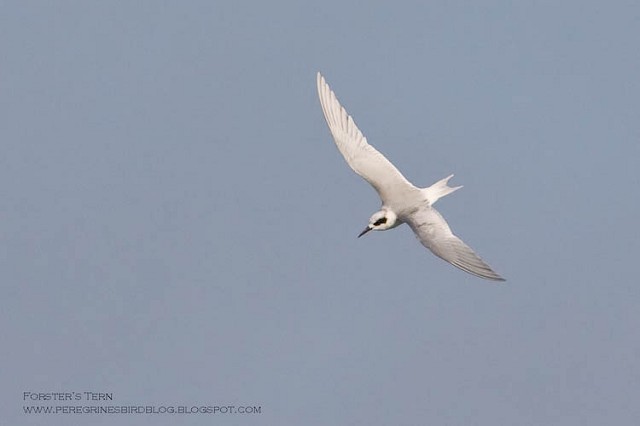
Forster's Tern, Killyleagh, Down (Photo: Craig Nash)
Little doubting the cream of the crop as far as gulls are concerned this week: the pink adult Ross's Gull that flew north past Seaton Sluice (Northumberland) on 25th was head and shoulders above a still-impressive selection of rare and unusual gulls around the country. Somerset entertained a neat little American double-act this week with both Franklin's Gull and Bonaparte's Gull in the county. The second-winter Franklin's Gull was at Keynsham from 20th-23rd, and then appeared in the roost at Chew Valley Lake on the latter date. Chew was obviously to its liking, as it spent the 24th there before relocating to the evening roost at Torr Reservoir on 25th. Nearby at Cheddar Reservoir, a delightful first-winter Bonaparte's Gull appeared on 22nd, and was still present to 26th. In Scotland, an adult Bonaparte's Gull was seen again on the Ugie Estuary (Aberdeenshire) on 22nd-23rd with, presumably, a different adult being found at Thurso (Highland) on 25th. At least 14 Ring-billed Gulls were reported over the past seven days. A new first-winter was on the Gann Estuary, Dale (Pembrokeshire) on 21st-25th, and was joined by a second-winter on 25th. The first-winter at Lamby Lake (Glamorgan) was still present to 26th, while other notable birds were an adult in Lytchett Bay (Dorset) on 20th and three new birds in Ireland: an adult at Tramore (Co. Waterford), a second-winter at Seafield (Co. Clare) on 23rd and an adult at Lough Aderra (Co. Cork) on 24th. There was no news this week on either of the American Herring Gulls in Galway so it's straight on to Caspian Gulls with around a dozen reported this week, six of which (all first-winters) were at the London Wetland Centre WWT on 24th. Single birds were also reported in both East and West Sussex, while a second-winter bird was seen passing Cley (Norfolk) amongst tens of thousands of shoreline gulls on 25th. Once again, 60 or so Glaucous Gulls were reported over the course of the week, but the figure is hard to judge accurately this week, with the potential for some duplication in Northumberland and Cleveland, with numerous records in both counties. Five juveniles were seen at Cowpen Bewley (Cleveland) on 21st, while four young birds were at Swillington Ings (West Yorkshire) on 24th. The cold weather saw a rise in the number of Iceland Gulls noted around Britain and Ireland this week, with around 125 birds present. Nimmo's Pier (Co. Galway) claimed 17 birds on 21st, while 10 were at Stornoway, Lewis (Outer Hebrides) on the same date. Seven birds lingered around Mallaig (Highland) to 24th at least and four or more were on St. Mary's (Scilly) on 20th. Kumlien's Gulls once again reached the half dozen mark; the dark second-winter was around Stranraer and Loch Ryan (Dumfries & Galloway) from 20th-22nd, while a third-winter was at Larne (Co. Antrim) on 20th. The adult was again at Draycote Water (Warwickshire) on 21st, while further second-winters were noted at Fraserburgh (Aberdeenshire) and Nimmo's Pier (Co. Galway) on 23rd and 24th respectively. The latter date saw a juvenile noted on Lewis (Outer Hebrides). Two Forster's Terns remained in Ireland during the week, at Killyleagh Harbour (Co. Down) from 20th-24th at least and in Galway Bay; also to 25th.

Bluethroat, Winterton-on-Sea, Norfolk (Photo: Connor D. Rand)

Black-bellied Dipper, Watton, East Yorkshire (Photo: Mark Coates)
A male White-spotted Bluethroat was a pleasing east-coast arrival at Winterton (Norfolk) on 26th, somehow managing to battle through the cold northerly winds that had dogged the east coast for much of the week. In Cornwall, the presumed "Eastern" Yellow Wagtail was seen again at Trevollard near Saltash (Cornwall) on 22nd-23rd. Around 50 Waxwings remained in place this week with the flock at Dunblane (Forth) the largest noted this week (26 birds present there on 20th). A dozen were still at Longforgan (Perth & Kinross) to 24th, while others remained in Derbyshire and West Yorkshire. The Dark-breasted Barn Owl was still being seen at Wacton Common, Long Stratton (Norfolk) to 25th at least, while the Black-bellied Dipper at Watton (East Yorkshire) was still present to 26th.

Hume's Leaf Warbler, Stockton-on-Tees, Cleveland (Photo: Stef Mcelwee)
Leading the way in terms of the warblers this week was the remarkably early Great Reed Warbler found at Porth Hellick, St. Mary's (Scilly), on 23rd and still present there on 26th. The sixth record for the islands, this bird is Britain's earliest by three weeks (the earliest record prior to this being at Slapton Ley, Devon on April 13th 1981). The two Hume's Yellow-browed Warblers remained at Tehidy CP (Cornwall) to 25th and at Stockton-on-Tees (Cleveland) to 25th. Just two Yellow-browed Warblers this week: the bird in Central Park, Plymouth (Devon) was still present to 25th and the same date saw one noted again at Rosewarne, Camborne (Cornwall). In Dorset, the Pallas's Warbler at Two Mile Coppice, Weymouth, decided to start singing from 21st, and was still doing so to 26th.

Great Grey Shrike, Cross Inn Forest, Ceredigion (Photo: Marc Hughes)
In Suffolk, two Penduline Tits were again seen at Minsmere RSPB on 24th-25th (after one was heard only on 22nd). A Rose-coloured Starling was seen in west Cornwall, at Pendeen, on 23rd. Fourteen or so Great Grey Shrikes this week included three birds in Gloucestershire, three in Wales and one in Highland, at Aultnamain, on 22nd.
Photo of the Week
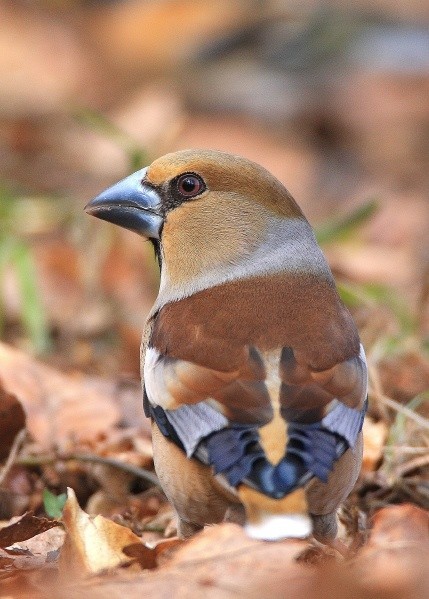
Hawfinch, Forest of Dean, Gloucestershire (Photo: Lewis Thomson)
Lewis Thomson's portrait of a Hawfinch on the ground is a great example of how photographic techniques can combine to create an image with impact. The starting point here is the interest value inherent in capturing a striking bird that few of us have ever seen up close. The next element is placing the bird in its natural environment, with rich, complementary colours that make it look 'at home'. Lewis has then got down to the bird's eye-level to give a sense of intimacy with the bird and has used a wide aperture setting to isolate the bird from a defocused foreground and background, creating a sense of depth and emphasising the bird's distinctive facial features. The hard part is then timing the shot at the exact moment of a perfect pose, in this case the bird's body facing directly away from the camera with a 90-degree head-turn. Finally, a strong vertical composition emphasises the pose, the right third-line leading the eye up the bird's back and the upper third-line leading it across to the finch's awesome bill.
Other notable photos

Black-tailed Godwit, Marshside RSPB, Lancashire (Photo: Tom Charles)

Barn Owl, undisclosed site, Norfolk (Photo: Nigel Pye)
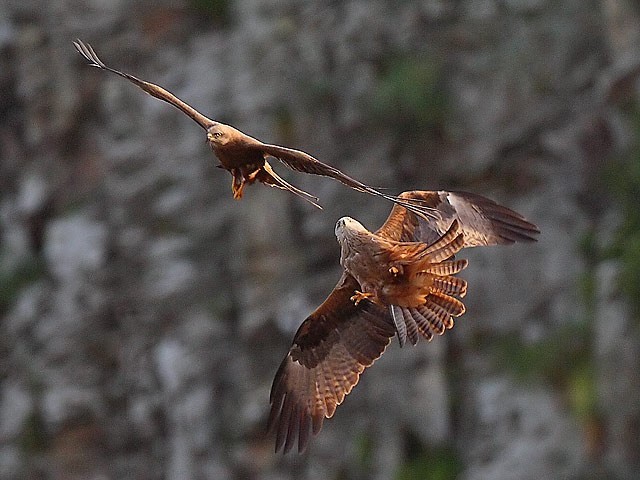
Black Kite, Spain (Photo: Steve Fletcher)

Waxwing, Bingley, West Yorkshire (Photo: Marcus Conway)
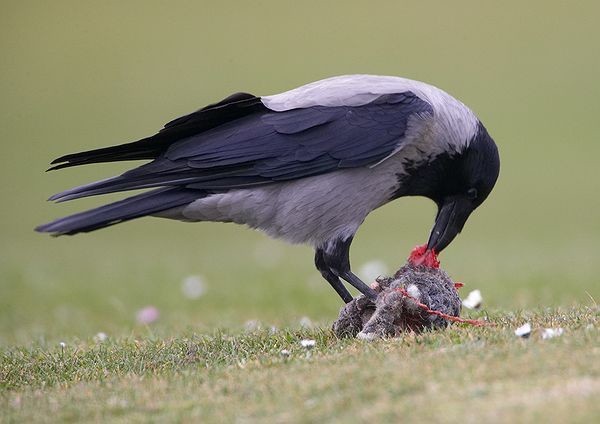
Hooded Crow, Ramsey, Isle of Man (Photo: Sean Gray)

Brambling, Forest of Dean, Gloucestershire (Photo: Lewis Thomson)

Reed Bunting, Tadlow, Cambridgeshire (Photo: Mike Lawrence)

Jay, undisclosed site, Cheshire (Photo: Richard Steel)
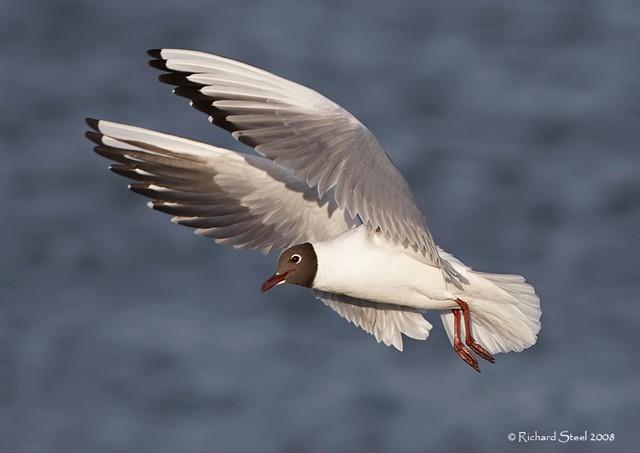
Black-headed Gull, New Brighton, Cheshire (Photo: Richard Steel)

Twite, White Holme Reservoir, West Yorkshire (Photo: Marcus Conway)

Cormorant, Peel, Isle of Man (Photo: Sean Gray)

Great Crested Grebe, Kilconquhar Loch, Fife (Photo: John Anderson)

Ring-billed Gull, Beddmanarch Bay, Anglesey (Photo: Mike Atkinson)

